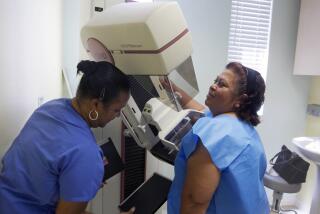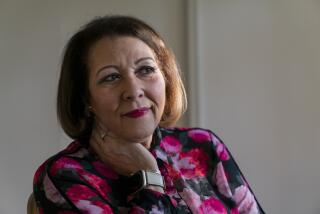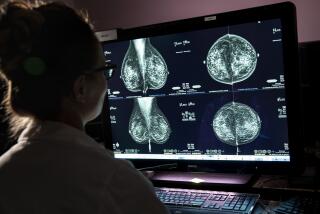Study Finds Misreadings in Breast X-Rays
WASHINGTON â Radiologists examining mammogram X-rays gave false-positive cancer readings up to 15.9% of the time, with the youngest and most recently trained doctors having two to four times the false-positive rate of older radiologists, a study finds.
The study, in the Journal of the National Cancer Institute, found that the rate of false positives could be reduced significantly if radiologists could compare films from previous mammograms.
Dr. Joann Elmore of the University of Washington School of Medicine in Seattle said that the rate of false positives--breast cancer mammogram screenings that require follow-up tests--is becoming increasingly common in the United States but that it should not discourage women from having annual screenings.
âMammography is not a perfect test [for breast cancer], but it is the best test we have,â said Elmore, first author of the study. âWomen should realize that they have a 10% chance of being called back for additional tests.â
The results of the study, she said, carry this message: Women should continue to have mammograms, but they should try to return to the same testing facility each time so radiologists can compare past test films. False positives are reduced by about 70% when radiologists compare current films with past images, Elmore said.
The study involved an evaluation of mammogram readings from 2,169 women by 24 radiologists in a community clinic practice from 1985 to 1993, which gave time for follow-up studies of the patients. The study analyzed the rate of false-positive interpretations by the doctors, then related that to the experience and training of the radiologists and to the patientsâ ages and other characteristics.
It found that the false-positive rate ranged from 2.6% to 15.9%. But when this rate was adjusted for the effect of patient characteristics, such as age, the false-positive rate was 3.5% to 7.9%. Age affects the false-positive rate because breast tissue is denser in younger women, which makes their mammograms more difficult to interpret.
The study found that doctors who graduated from medical school in the last 15 years had false-positive rates two to four times higher than more experienced doctors. Elmore suggested that the young doctors may have had training that concentrated on finding cancer without emphasizing that false positives âcan cause a lot of women who donât have breast cancer to be called backâ for more tests. Older doctors also have more experience, she said, and âexperience matters.â
âRadiologists who have been reading mammograms for 20 to 30 years have seen a lot of cases and hopefully learned,â she said.






